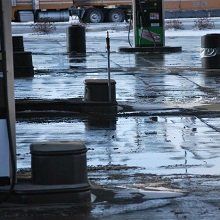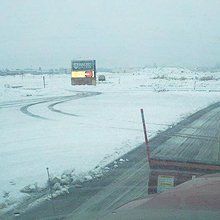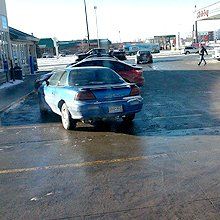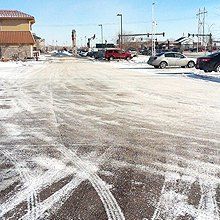Get all the snow removal information you need
Use the information below to get a better understanding of the tools, tactics, and options available to us for snow and ice removal services. Depending on your property, Asplin Siteworks Inc will work out a solution that best meets your needs. Contact us today.
De-icing and anti-icing
Anti-icing: A preventative strategy that involves salting a surface prior to a snow storm to prevent any ice from bonding.
De-icing: A reactive strategy involving breaking the bond that any ice has made with a surface. While anti-icing is a preferred strategy whenever possible, de-icing is often the only option to providing an ice-free surface.
Chemicals and materials
Sand: Sand can provide some amount of traction to an icy surface, but it does not melt ice or snow and is potentially harmful to the environment as it drains into water systems.
Magnesium chloride (MgCl): MgCl is a relatively costly chemical that gives off heat as it dissolves when applied as a solid, providing a fast result. It can also be applied as a liquid, prior to a storm.
Calcium chloride (CaCl): CaCl is available in solid and liquid forms, and performs effectively in severely cold weather. It works quickly, but can also damage the pavement it's applied to, corrode metal, and leave residue on entryway carpets.
Calcium magnesium acetate: This acetate is not a salt. It is environmentally friendly, non-corrosive to metals, and is best used as a liquid anti-icing solution. It is not an effective solid-state de-icing solution.
Sodium chloride (NaCl): NaCl, also known as rock salt, is the chemical of choice when it comes to ice and snow prevention and removal.
It is readily available, and relatively inexpensive. It can be combined with other chemicals to enhance its effectiveness in colder weather, and works well on roads or parking lots with a large amount of traffic.
The downsides are that it can be harmful to roadside vegetation, and can take longer than other chemicals to turn into a brine solution. This can be remedied by pre-wetting or combining chemicals.
Blends: Salts and acetates all have unique properties and specialized uses. Combinations or these chemicals, as well as synthetic blends, allow single products to fill multiple roles in the ice and snow removal process.
Criteria for chemical selection
Cost: We take into account the purchasing cost vs. the actual cost, if any special handling equipment is necessary, and if there is any potential for environmental damage when deciding on which chemical is right for the job.
Purpose of application: Chemicals are selected based on the need for either an anti-icing or de-icing solution.
Type of surface: Depending on the surface of the property, certain chemicals will be more effective than others.
Customer requirements: If a client stipulates the prohibition of a certain type of chemical or a specific chemical, the choices become more limited.
Environmental concerns: If the area in question is vulnerable to stress, certain chemicals can be harmful to the environment, especially when overused.
Temperature and climate regional differences: Depending on the climate in question, some chemicals may be more or less effective.
Final factors to consider:
A thorough understanding of all the characteristics of each chemical allows us to select chemicals that meet our needs and business philosophy.
Pre-wetting
Pre-wetting is when dry salt crystals are coated with a film of liquid to provide better-melting action and lower the effective melting temperature of the chemical.
Advantages of pre-wetting: Pre-wetting quickens the formation of brine, allows more salt to be retained on the surface it's applied to, and increases the efficiency of the salt, meaning we need to use less, and less is wasted.
Methods of pre-wetting application: Pre-wetting occurs on the truck, in each leader-bucket prior to the salt being placed in the spreader, in the spreader, and at our stockpile before the winter season.
Using liquids: With liquid anti-icing, a liquid is sprayed onto a surface prior to a snow storm, prevents a surface-to-ice bond, and allows for a much more cost-effective form of ice and snow removal and control.
Use of chemicals and the environment
Effects of salt on the environment: Salt can enter the environment through a variety of pathways, all of which involve water.
The effects of de-icing salts on soil: De-icing salt can pollute ground water, surface water, and soil. NaCl affects soil through a process called cation exchange which can decrease permeability, aeration, and fertility.
The process is reversible as the salt concentrations become diluted as they pass through the soil.
The effects of de-icing salts on vegetation: De-icing salts can injure vegetation through soil uptake and salt coating, all of which result in the death of the plant.
Evidence of damage shows up as needle damage and browning in conifers, bud and twig damage in deciduous trees, and burnt lawns. It can also reduce the cold-hardiness of some vegetation.
The effects of de-icing salts on aquatic systems: Salt can potentially affect aquatic systems by interfering with the circulation patterns of a body of water.
Not all chemicals affect the environment in the same way: Some chemicals may contribute less to the damage of bodies of water, while others may stimulate the growth of undesirable plant life.
Calcium magnesium acetate and potassium acetate or considered the most environmentally friendly of all the de-icing chemicals.
Sound snow, and ice management practices: By identifying the salt-sensitive areas of your property, we can apply the principles of sound snow and ice management.
Call today to receive a FREE estimate!
24-hour emergency services are available!







